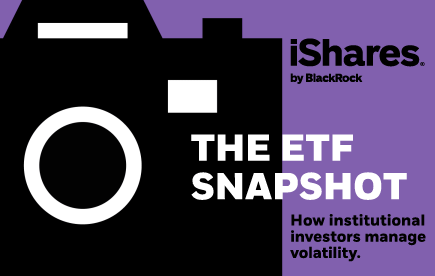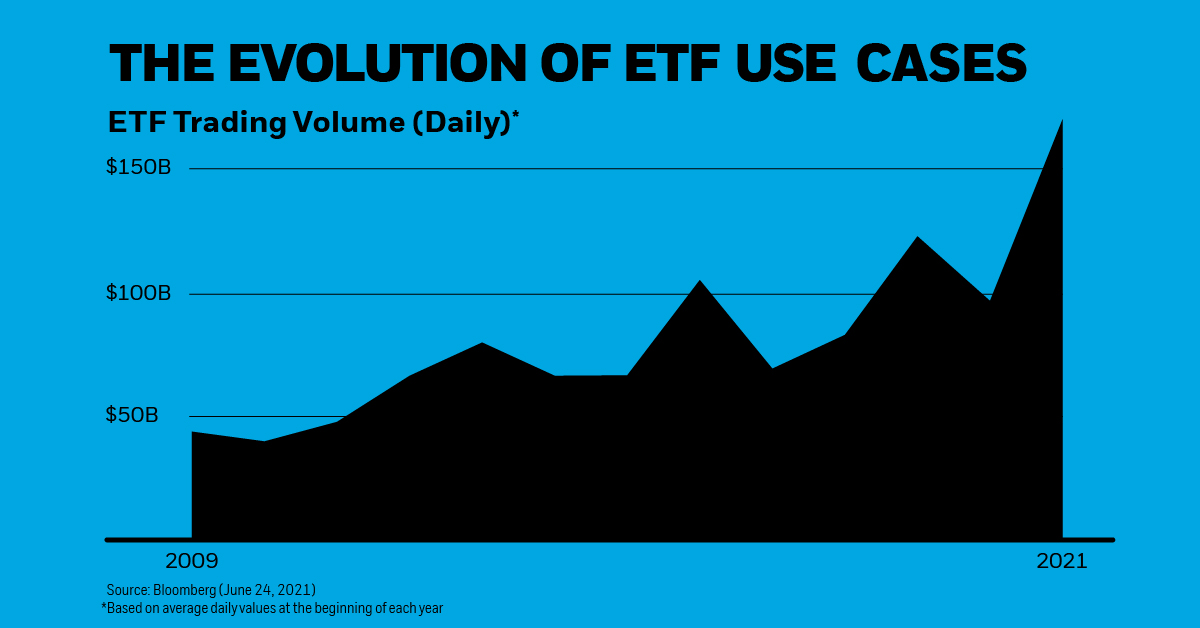The Evolution of Institutional ETF Use Cases
The following content is sponsored by iShares

Download the ETF Snapshot for free.
The Evolution of Institutional ETF Use Cases
Over the last 25 years, ETFs have exposed millions of U.S. investors to low-cost investments. Yet ETFs go far beyond low-cost and broad exposure. Institutional investors use ETFs for many functions, from bond sourcing to complementing derivatives.
In this infographic from iShares, we show the evolution of ETF use cases over several decades. It’s the fourth in a five-part series covering key insights from the ETF Snapshot, a comprehensive report on how institutional investors manage volatility.
How Have ETF Use Cases Evolved Over Time?
1993: The first U.S. ETF launches
Before: Investors looked to individual stocks or mutual funds to create a diversified portfolio.
After: When the first S&P 500 ETF was launched in the U.S. in 1993, exposure to a broad market became possible with a single security, removing several barriers to entry.
1996: First international ETF launches
Before: Typically, investors used foreign exchanges or depository receipts to gain exposure to international markets. The challenges included additional costs, tax implications, research needs, and additional currency risks.
After: With the first international ETF in the mid-1990s, diversification was possible through broad-based foreign indices.
2002: First bond ETF launches
Before: Investors relied exclusively on a network of bank or broker inter dealers.
After: In a single security, investors could purchase a diversified basket of bonds. The result was typically more efficient trading and tighter bid-ask spreads.
2005: First sustainable ETF launches
Before: Socially responsible mutual funds emerged in the 1980s, screening out weapons, gambling, tobacco, and other categories. Often, mutual funds tracked the Domini Social Index, made of mostly 400 large-cap U.S. stocks.
After: With the launch of the first sustainable ETF, investors have a greater variety of sustainable investment options. This paves the way for hundreds of ESG ETFs to follow in the next 15 years.
Want more institutional insights into ETFs?
Download The ETF Snapshot for free.
Today: Institutional ETF Use Cases
Before, cash and a variety of vehicles were used across investment strategies. The problem is that cash drag, lack of transparency, and poor liquidity can hurt performance.
According to an Institutional Investor report published in 2021 based on a survey of 766 decision makers, many institutions are using ETFs to overcome these challenges today:
1. Bonds
When bond markets faced severe bottlenecks during COVID-19, 54% of institutions utilized bond ETFs to price, source, and transact bonds.
2. Derivatives
During the peak volatility of 2020, 52% of institutional investor respondents used ETFs as a complement or replacement for derivatives, according to the survey.
3. Rebalancing
70% used ETFs to rebalance following historic levels of volatility.
4. Multi-asset strategies
65% of asset managers use ETFs as a part of their multi-asset strategies.
5. Tactical adjustments
Six in ten institutions use ETFs for targeting market exposures.
6. Manager transitions
When firms are transitioning to a new manager, 32% use ETFs.
7. Liability-driven investment strategy (LDI)
73% of insurance and pension funds used ETFs in their liability-driven investment strategy, which requires having enough assets to cover liabilities, both current and future.
Nature of Design
Historically, ETFs have offered a gateway to more efficient markets. Because of the transparency and flexibility of ETFs, institutions continue to find creative ways to use them.
Download the ETF Snapshot for free.
-

 Sponsored3 years ago
Sponsored3 years agoMore Than Precious: Silver’s Role in the New Energy Era (Part 3 of 3)
Long known as a precious metal, silver in solar and EV technologies will redefine its role and importance to a greener economy.
-

 Sponsored7 years ago
Sponsored7 years agoThe History and Evolution of the Video Games Market
Everything from Pong to the rise of mobile gaming and AR/VR. Learn about the $100 billion video games market in this giant infographic.
-

 Sponsored8 years ago
Sponsored8 years agoThe Extraordinary Raw Materials in an iPhone 6s
Over 700 million iPhones have now been sold, but the iPhone would not exist if it were not for the raw materials that make the technology...
-

 Sponsored8 years ago
Sponsored8 years agoThe Industrial Internet, and How It’s Revolutionizing Mining
The convergence of the global industrial sector with big data and the internet of things, or the Industrial Internet, will revolutionize how mining works.









